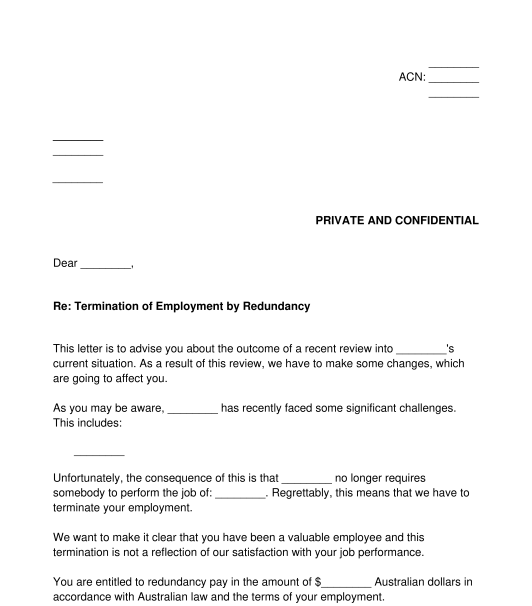 22/11/2024
22/11/2024

Answer a few questions and your document is created automatically.

Your document is ready! You will receive it in Word and PDF formats. You will be able to modify it.

 22/11/2024
22/11/2024
 Word and PDF
Word and PDF
 1 to 2 pages
1 to 2 pages
This Employee Termination Letter (Redundancy) is designed to be used by an employer to terminate an employee for redundancy. If the employer is terminating the employee for another reason, such as poor performance, use our Employee Termination Letter (General).
This Letter of Termination of Employment (Redundancy) is only for use if the employee is genuinely being made redundant. It is not for use in any other circumstances (for example, if the employee is underperforming).
On the other hand, an Employee Termination Letter (General) is for use when an employee is underperforming.
Employers must give an employee written notice of the day of termination when ending the employee's employment. This letter provides a useful and straightforward structure to help employers comply with this obligation.
Redundancy occurs when the employee's job no longer needs to be done by anyone. The job, rather than the employee, becomes redundant. Redundancy does not occur as a result of the employee's conduct or job performance.
If redundancy occurs, then the employee may be entitled to a lump sum payment of redundancy pay. The employee may also be entitled to a period of notice (or payment in lieu of that notice).
Even before preparing this letter, if changes are happening in the employer's business, causing the employer to consider redundancies, then the employer should make sure to communicate regularly with employees. In many cases, a modern award or enterprise agreement may require the employer to consult with the employee regarding changes in the business. Early in the process, the employer should make sure that it understands its rights and obligations regarding redundancy. In particular, the employer will need to know whether redundancy will apply, and if so, the terms of that redundancy (such as processes to follow, amounts of redundancy pay and any minimum notice periods).
Minimum standards for employment are set in the National Employment Standards. However, if there is an applicable industrial instrument (such as an award or a registered agreement), then this may set additional requirements. In addition, a contract of employment or a workplace policy might also set additional requirements. In any case, the employer will need to comply with whatever requirements are most favourable to the employee. The National Employment Standards are only the minimum standards. For small businesses, it is also important to check the Small Business Fair Dismissal Code. Further information about these matters may be obtained from the website of the Fair Work Ombudsman. If the employer is still unsure about these obligations, then the employer may need to seek legal advice.
Once this letter is ready, the employer may sign and date it. The employer may then organise a meeting with the employee, and at that meeting, provide a copy of this letter to the employee. The employer should also keep a copy for their own records.
If the employee is entitled to redundancy pay or other assistance as part of the redundancy process, then the employer will also need to comply with those obligations.
This depends on a range of factors including the terms of the employee's contract, and the size of the employer's business. But there are a number of ways to find information about this:
In order to prepare this letter, the employer will need to provide information about the full names of the employer and the employee, the reason for the redundancy, the last day of work for the employee, any redundancy pay that the employee may receive and any other entitlements that the employee may receive.
The Fair Work Act 2009 (Cth) and the National Employment Standards apply to most employment situations in Australia.
However, in addition, many employment situations are also governed by modern awards or enterprise agreements. If such an award or agreement applies, then that will set out some additional minimum standards with which the employer must comply.
In addition, general principles of contract law, as provided by the common law, will apply to any employment contract.
You fill out a form. The document is created before your eyes as you respond to the questions.
At the end, you receive it in Word and PDF formats. You can modify it and reuse it.
Guides to help you
Country: Australia